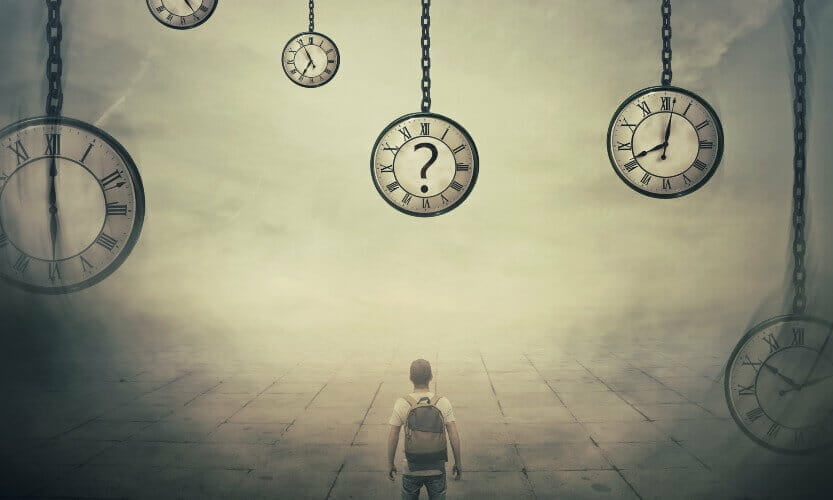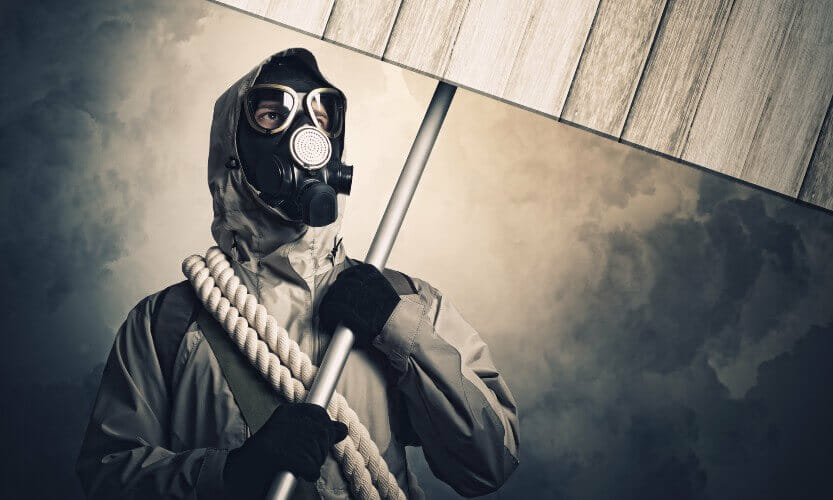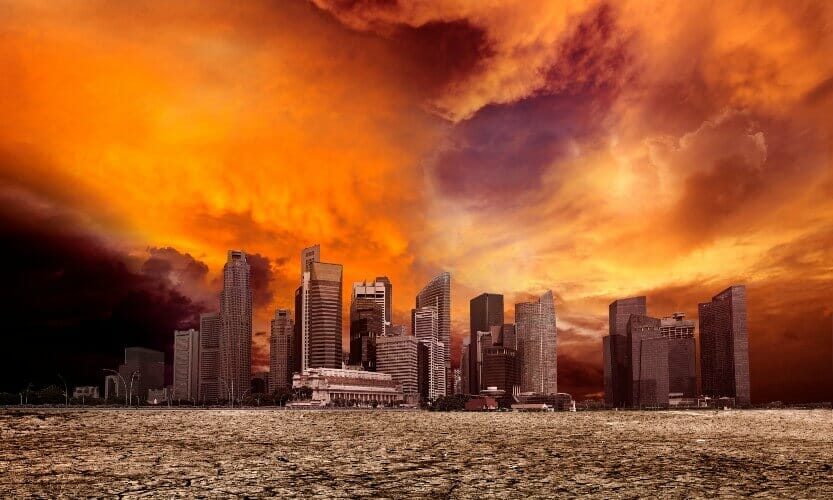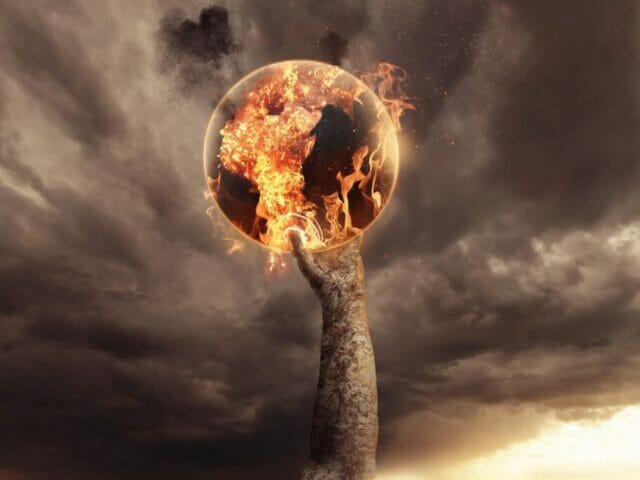Writing dystopian stories can be one of the most valuable things you can do.
Dystopian fiction is famous for its big, bold themes and the ground-breaking ways in which they’re conveyed.
So, if you’re looking for a fiction project, and you want a meaty challenge, look no further than writing the next great dystopian story.
In this article, we’ll cover how to write a dystopian story, as well as:
- What is a dystopian story?
- Key elements of a good dystopian story
- Dystopian story examples
- Our tips and tricks for how to write dystopian fiction
- Frequently asked questions
Read on to learn how to write a dystopian story.
What Is A Dystopian Story?
Dystopian stories are a subgenre of speculative fiction focused on the destruction of society. This can be due to totalitarian rule, international or civil war, apocalyptic events (and their post-apocalyptic effects), or injustice and suffering.
Often associated with Aldous Huxley’s Brave New World and George Orwell’s 1984, dystopian fiction as a literary genre began with Russian author Yevgeny Zamyatin and his book My — published in the US as We in 1924. Works like Zamyatin’s follow in the footsteps of fellow Russian Fyodor Dostoyevsky’s explorations of evil and freedom, setting the scene for what we know as dystopian stories today.
Dystopian novels cover topics like climate disaster, tyranny, nuclear war, anarchy, pandemic disease, extra-terrestrials, artificial intelligence (AI), and even zombies.
If a story is set in a dystopian future, it may also take on elements of science fiction e.g. technology and its implications.
So, what makes a good dystopian story?

Key Elements Of A Dystopian Story
This is where we get into the paradox of dystopian stories: that despite their weighty subjects, they can make for grippingly good reads. Let’s dive in.
Worst-Case Scenarios
The key to great dystopian stories is that they don’t tread lightly. Instead, they take our fears and anxieties and turn them up to eleven.
Worried about climate change? Here’s a thinly-veiled conceit that ends in disaster thanks to humanity’s morally apathetic, egocentric leaders (the film Don’t Look Up).
What about technological progress and the future of AI? Have some time-travelling cyborg assassins (The Terminator series).
These are film-based examples, as we’ll cover books below, but the point is that a powerful dystopian story doesn’t shy away from its premise — it pulls the problem apart like an onion to get readers thinking about complexities from differing angles and points of view.
And if we know anything about differing points of view, it’s what they can lead to.
Dramatic Conflict
But first, let’s take a step back. As I’ve covered in this guide to central conflict, a story’s conflict is the result of a protagonist’s want vs. obstacle. Due to the nature of dystopian fiction, you can bet any obstacle is going to be huge, with life or death stakes. This makes such conflicts strong, which is a major part of successful storytelling.
Now, if we think back to our definition of dystopian stories, in stories with themes about power structures, which create external conflict, anti-establishment characters will layer their own internal conflicts on top of that. This is where characterising different points of view can ground philosophical stances in reality, with clear choices for characters that readers can identify with.
Inventive World-building
It’s not all about concept, conflict and characters, though. Dystopian stories go big to convey big messages, so when you’ve got an apocalyptic scenario, it needs to be reflected in your dystopian world. As a result, world-building is where premise and conflict come together for effect; it’s also useful for characterisation.
Got a dystopian story based on a totalitarian government? How is that reflected in the way civil servants look, dress and live? What do they eat? Where do they sleep? How is this different to the general public — are they poor, or homeless by contrast?
Well-crated dystopian settings help stories feel authentic in fictional worlds.
As a writer, you can use this world-building to also build on a story’s themes.
Thematic Resonance
The way dystopian themes resonate can take on significance during periods of relevant upheaval. In 2017, George Orwell’s 1984 became a sudden bestseller after Donald Trump’s presidential inauguration; a big deal for a book published in 1949.
The broadest dystopian themes revolve around destruction, the abuse of power, and survival, and, depending on what’s top of mind in the cultural consciousness, such stories can galvanise people’s real-world opinions, which can impact future decisions and behaviour (as we saw in the US 2020 election).
Humanity As Good Or Evil (Or Both)
One of the fascinating things about dystopian fiction is who the author chooses to be on the side of good, or evil (or neither, in true ‘grey’ character style).
Is the protagonist a hero, an anti-hero or a closet villain? What about the supporting cast? Who is making the right choices, or the wrong choices, and why?
Human beings are complex, fuelled by emotion but capable of rational thought, and dystopian stories are an excellent vehicle for making the pitfalls of that duality scarily clear.
Yet dystopian novels can be uplifting, too. Of those that don’t end in tragedy as a cautionary tale against their themes, many strive to show the power of the human spirit and its enduring potential. Characters in these tales often labour through long, painful journeys to reach their goals, but that struggle is what makes their eventual success so fulfilling. We can’t help but find triumphing over adversity inspirational, and these dystopian books tend to stay with us long after we’ve finished reading.

Dystopian Story Examples
So, now that we know what makes a good dystopian story, let’s take a look at some dystopian books that do it well.
The Hunger Games Series By Suzanne Collins
The biggest entry to reignite interest in dystopian stories, The Hunger Games trilogy (and subsequent films) kick-started a movement in young adult (YA) fiction that paved the way for dystopian novels like Divergent and The Maze Runner.
Teenage protagonist Katniss Everdeen lives in Panem’s impoverished District 12, where she hunts to provide for her family. When her little sister is selected for the annual reality TV battle royale known as The Hunger Games, Katniss volunteers to take her place alongside other teens who will fight to the death in the Capitol — including a fellow District 12 boy who once saved her life. Being YA, there’s also a love triangle, and happily, the seeds of rebellion.
Remember what I said about worst-case scenarios, dramatic conflict and inventive world-building? This book’s got all three in spades, with a focus on youth leading the way in a hopeless situation.
1984 By George Orwell
Speaking of reality TV, the only ‘Big Brother’ we’re here to talk about is the original, chilling government version. Orwell’s dystopian story, written after the end of World War II, is a modern classic and a warning against totalitarianism.
Winston Smith lives under the watchful eye of the Party and its leader Big Brother, rewriting history in the Ministry of Truth. In defiance, Winston starts a diary, a capital offence given what he does for a living — the risk compounded by telescreens that watch and listen 24 hours a day. He also starts dating a female colleague, which is forbidden as only loyalty to the Party must exist.
What makes 1984 such potent dystopian fiction isn’t that the Party oppresses all the way down to love and sex, or that Winston is eventually found out, or that he’s tortured and reconditioned… it’s the ominous ending.
The Handmaid’s Tale By Margaret Atwood
After that last example, you may be wondering how much darker things can get. Answer? A lot. Welcome to Gilead.
June, who’s now known as Offred (a patronym for the man she’s assigned to), lives in the Republic of Gilead, previously the US, which is now controlled by right-wing extremists as a totalitarian, theocratic state. Offred is a Handmaid to her Commander Fred, and assigned to bear his children in monthly sex rituals witnessed by Fred’s wife, as infertility is the norm thanks to chemical warfare. With no freedom, and the Eyes (the secret police) everywhere, Offred has no real options — or so she thinks.
According to Atwood: “When I wrote The Handmaid’s Tale, nothing went into it that had not happened in real life somewhere at some time.” That’s a big statement, and a testament not only to her research, but also her commitment to authenticity. Next time you’re watching the TV show, keep that in mind.
Brave New World By Aldous Huxley
And the darkness keeps on coming, though it’s cloaked in Huxley’s wit and irony. Despite being a decade short of its 100th anniversary, Brave New World is a brave iconic take on dystopian writing, with lots still left to offer readers.
Bernard Marx lives 600 years ‘after Ford’ in the dystopian future World State, where people, like cars, are mass-produced with individualism conditioned out. Yet Bernard’s not the real hero of this story — John ‘the savage’ is, who Bernard meets on a trip to the wild Savage Reservation, and brings home. But when Bernard is eventually banished, how will babe in the woods John cope with civilisation?
This dystopian novel is high-concept, so there’s a lot to unpack (e.g. social norms like promiscuity and Valium-like ‘soma’), and John’s ending is achingly poignant. With a theme like truth over happiness, it’s not hard to see why.

Lord Of The Flies By William Golding
We started this section with characters aged 12-18 in The Hunger Games — now we turn to characters aged 6-12 in Golding’s story about the surprisingly few steps between civilisation and a dystopian society.
Ralph and a group of British schoolboys crash-land on a deserted island during a nuclear war; the group voting Ralph as their chief, with Piggy advising him. But hunter Jack wants to lead too, recruiting other boys with his barbarous violence; soon, most of the boys have joined Jack. Things turn ugly when Piggy’s glasses, used to make fire and smoke signals, are stolen and boys are killed. Ralph escapes and lives, saved by a British naval officer, but it’s too late for Piggy.
Despite the idyllic tropical island, this dystopian story’s main theme is that humanity is essentially evil (yes, even kids). Another post–World War II novel, it’s also an allegory for war and leadership.
Fight Club By Chuck Palahniuk
For our last example, say hello to Palahniuk’s short story turned novel (and two comic book sequels), which disappointingly, isn’t on popular dystopian fiction lists. The book presents modern life and consumerism as a dystopian regime that needs blowing up, and certainly tries to — succeeding in the 1999 film adaptation. Yes, it’s satire and a damning social critique, but it’s also anarchic at heart and that’s a fundamental source of its conflict, with the twisty alter ego conflict layered on top. I’d say more, but you know the first rule of Fight Club…
Now, onto what we’re here for (and what we can talk about) — how to write a dystopian story.
How To Write A Dystopian Story
Given the calibre of examples covered, writing a dystopian story might feel like an insurmountable task — but in practice, the steps aren’t dissimilar to ordinary fiction.
So, how do you do it?
For ease of use, I’ve broken it down into 5 key steps.
Here’s how to write a dystopian story:
Choose Your Problem
This is where you choose the issue (or theme, then brainstorm from there) that you want to explore. For many dystopian authors, and those in other speculative fiction subgenres with a dystopian society, the first nugget of an idea often arises from real life.
Atwood’s idea for The Handmaid’s Tale came to her after a conversation during the 1980s about women outside the home, and what would force them back. Tomi Adeyemi’s award-winning YA fantasy series Children of Blood and Bone was inspired by racism and extreme police brutality.
Both are powerful examples of taking a real-world issue and expanding it into a successful dystopian premise, which brings us to our next step.
Make It A Premise
You’ve chosen your problem, and now you want to flesh it out into a full concept. Excellent! This is where more brainstorming helps. So does an example.
Say you’re looking at the government and wondering how they get things so wrong (a little meta, but let’s go with it). Make a list of what they’re mismanaging right now, and pick what you see as the biggest issue. Electricity and gas? Inflation and the cost of living? Or something else? Now, what’s the absolute worst thing that could happen from this problem? Got it? Great. Then multiply it by ten.
If it’s electricity and gas, maybe your premise is that they no longer exist; or maybe they only exist for certain people. Tease out the how and why. What happened for some people to lose these utilities, or keep them? What does this difference look like — do the have-nots use fire to cook and heat instead, and what does this mean for the environment? These knock-on effects will make your premise all the more real.
Choose Your Protagonist
For some writers, you’ll arrive at your premise with a character in hand. For the rest of us, you need to think about what you want from your dystopian story, and what kind of protagonist works best.
Do you want your main character to win, or is your aim an exercise in caution (see 1984)? The answer will determine what traits and skills should be inherent to your character, or learned throughout the story.
And while we’re here, don’t forget your supporting characters. With the weight of the dystopian world on your protagonist’s shoulders, they’ll need help and support, not to mention people that challenge them, along the way.

Check Your Conflict
Now that you’ve selected your problem, expanded it into a compelling premise, and have a protagonist in mind, it’s a good time to confirm that your conflict is strong enough to carry your story.
Dystopian novels tend to fall into the category of external conflicts: character vs. society, technology, nature, the supernatural etc. With a strong central conflict, your main character is forced to reveal themselves through action and the decisions they continue to make as the plot advances. Remember: your character’s want + its obstacle = conflict.
Build Your World
If you’re like me, you’ll have been making notes as you go, but for those new to world-building, it’s completely fine to start once you’ve gotten your head around the steps above.
Bringing your story to life involves building on earlier questions to craft your dystopian world and its people i.e. nature and geography, and people and governance (as well as various cultures).
This not only means the physical landscape, climate and seasons, resources, and plants and animals, but also a population’s races, genders, sexualities and classes, plus language and religion, norms, values and economic systems.
Tips For Writing Dystopian Fiction
Okay, you know how to write a dystopian story in theory — but you want a few more tips and tricks. Don’t worry, I’ve got you covered.
Here are five tips for writing dystopian fiction:
- Pick an Issue You’re Passionate About: Circling back to our 5 steps for how to write a dystopian story, if you’re stuck on choosing your problem, what issues happening around the world get you angry? What matters to you? Scour news and current affairs for meaningful inspiration. Having own-voice experiences can be beneficial here, too.
- Bring the Catastrophe: Alternatively, if translating your problem into a premise is the sticking point, you may be thinking too small. Now is not the time to round down — don’t just go big, go gargantuan! Think of the most extreme outcome and explore that.
- Nail Your Main Character’s Backstory: If you’ve followed the first five steps but are stumbling over your protagonist, maybe a character profile will help. You can use everything you’ve noted about your dystopian setting to flesh out your protagonist’s background, role and goals, characteristics, and personal conflicts to layer accordingly.
- Research, Research, Research: While much of your research will go into world-building, you’ll still need to fact-find for your premise. If your story is based on large-scale war, authentic specifics are crucial, whether that’s reading up on World War II or going down the science fiction path of something like H. G. Wells’ War of the Worlds.
- Read the Dystopian Greats: Speaking of which, if you want inspiration, read dystopian stories like the examples listed in this guide, but also read other dystopian writing widely. This will help you learn the ropes (and tropes), as well as any pitfalls you’d like to avoid in your work.

Frequently Asked Questions
How Do You Start A Dystopian Fiction Story?
You start a dystopian fiction story like you would any other: with a hook and inciting incident. For dystopian stories, that hook is your unique premise and what it means for your dystopian world. You also need to introduce your protagonist and how they fit (or don’t fit) into the world, which the inciting incident makes clear. The best dystopian fiction stories do this in the first few chapters, then further the plot while deep-diving into character, the world and the central conflict.
What Are 3 Common Themes In A Dystopian Story?
The 3 most common themes in a dystopian story are destruction, the abuse of power, and survival. Destruction can be technological, nuclear or environmental, even apocalyptic, with mass poverty and violence as outcomes. Abuse of power, often governmental, can include censorship, extreme oppression, and loss of personal or cultural identity. Survival then becomes the goal, whether it’s physiological as in air, food, water and shelter, or psychological like mental health.
What Are The 5 Elements Of Dystopia?
The 5 key elements of great dystopian stories include: worst-case scenarios, dramatic conflict, inventive world-building, thematic resonance, and depicting human beings as good or evil. For a dystopian premise to be successful, it requires a significant potential for harm, a strong external conflict, a fully realised, authentic-feeling world, big themes with broad appeal, and an answer to the question of whether humanity is the problem or the solution.
What Is The Opposite Of Dystopian?
At the opposite end of the dystopian spectrum is utopian fiction, which depicts an ideal or utopian society. English philosopher Sir Thomas More’s Utopia (1516) coined the term with his perfect island society that cut itself off from the world. Utopian fiction is around 500 years older than the dystopian genre, and in it, authors invert problems to show what could be, rather than what is; ecological sustainability might be explored by depicting a human society in harmony with its natural environment, for example.
Writing Dystopian Fiction Stories
There’s a lot to love about dystopian fiction. Yes, it can be dark. It can be harrowing. But from darkness comes enlightenment, and thankfully, we can experience these dystopian stories from the safety of our homes.
Dystopian novels guide us and teach us where to do better in the hope of a better future. Sometimes they’re bitter pills to swallow, but nothing truly worth it is easy. That’s where doing the work comes in.
If this line of thinking appeals, now that you know how to write a dystopian story, it may just be your time to begin.
Jericho Writers is a global membership group for writers, providing everything you need to get published. Keep up with our news, membership offers, and updates by signing up to our newsletter. For more writing articles, take a look at our blog page.










